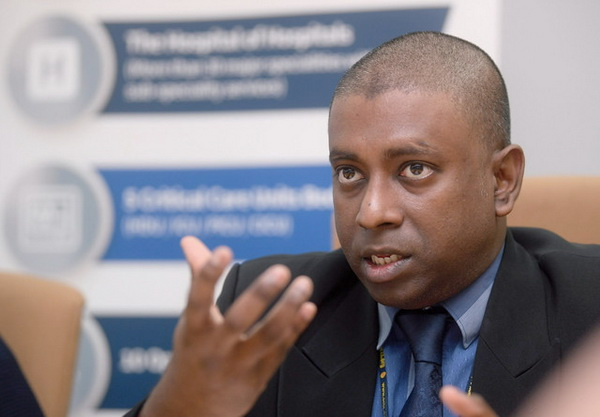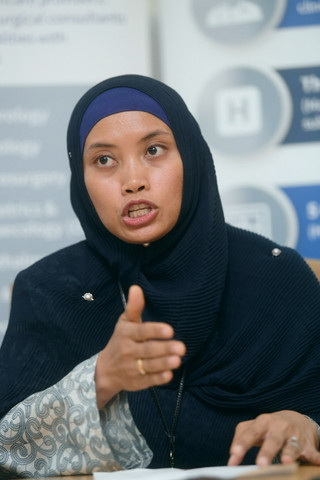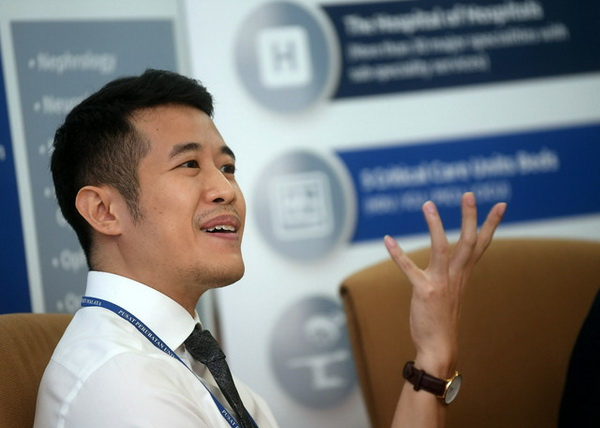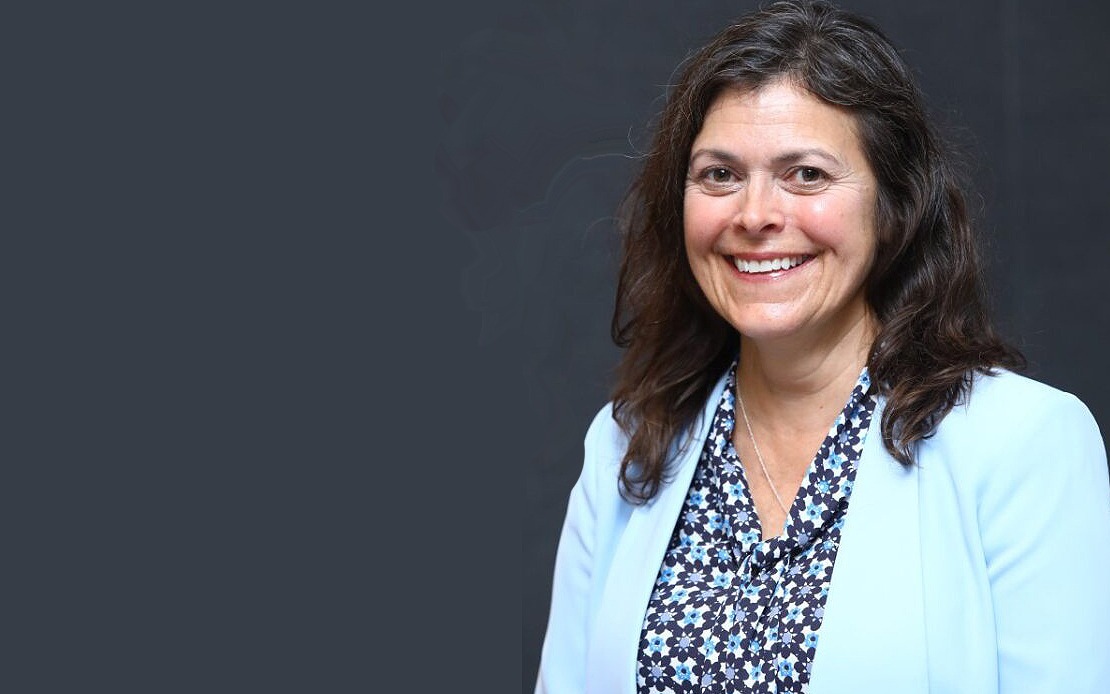VATS & SBRT: The Future Of Lung Cancer Treatment In UMSC

By Jenny Imanina Lanong Abdullah dan Murni Mat Nasri
This is the second of a two-part article on lung cancer treatment.
KUALA LUMPUR (Bernama) -- Traditionally, surgery for lung cancer is done via a thoracotomy, which requires the cutting of muscles and spreading of the ribs before entering the chest to remove the cancer.
In 1997, Tokyo National Cancer Hospital vice director Tsuguo Naruke led a team of surgeons in a successful operation on a 69-year-old woman who was diagnosed with an early stage lung cancer.
The operation, performed via the Video-Assisted Thoracic Surgery (VATS) was reported as the first of its kind in the world.

UMSC clinical oncologist Dr Adlinda Alip.
In performing the surgery, Naruke used dissecting and knotting forceps while watching the inside of the lung shown on a television monitor by way of a thoracoscope. He then cut the cancer-affected lobe and extracted the part through six-centimetre incisions on both sides of the body.
The operation lasted six hours with little bleeding and the patient requiring no blood transfusion.
Since then, minimally invasive surgery became an integral part of modern medical technology.
ABOUT VATS
Minimally invasive surgeries are performed via small incisions designed to limit trauma, pain and the risk of infection for the patient as compared to open surgery.
UM Specialist Centre ( UMSC ) consultant cardiothoracic surgeon Dr Sivakumar Krishnasamy told Bernama recently that all lobectomies would be considered for VATS, where appropriate. (A lobectomy is a surgery to remove one of the lobes of the lungs.)
“However, the minimally invasive surgery is not applicable for all lung cancer cases because to perform the surgery, the size of the tumour and location require serious consideration, and thereafter whether the surgery can be done safely. Also, the main difference between open surgery and VATS is the ‘scarring’.
"When patients have a smaller scar, they have less tissue trauma and pain. Recovery is better with a shorter hospital stay. Hence, patients are motivated to undergo the next stage of treatment, if required,” he added.
Elaborating on this, he said if a patient diagnosed with positive lymph nodes or with a cancerous tumour that is more than four centimetres were to undergo VATS to remove the cancer, he would be more prepared for the next treatment line which is chemotherapy plus-minus radiotherapy. Open surgery patients, in comparison, may experience a longer stay in the hospital.
Elaborating on this, he said a patient diagnosed with positive lymph nodes or with a cancer that is more than four centimetres, upon undergoing VATS to remove the cancer, would be more prepared for the next treatment line which is chemotherapy plus-minus radiotherapy, as compared to open surgery patients who may experience a longer hospital stay.
Emphasising that the patient’s safety is given top priority, Dr Sivakumar pointed out that VATS can be converted into open surgery when the need arises, especially in situations of difficult tumour removal or bleeding.
“We are aiming to achieve a full VATS approach at UMSC , but the circumstance may vary during the actual procedure. For instance, if a big node is stuck in the main blood vessel and if I’m unable to conduct a keyhole (minimally invasive surgery carried out through a very small incision), I would then convert the procedure to open surgery.
"The primary aim is to remove the cancer and have the lymph nodes accurate for staging. Safety of the patient is crucial and the key factor,” he added.
According to Dr Sivakumar, based on his patients’ experience, minimally invasive surgery provides the added advantage of early mobility and faster adjuvant treatment options when compared to open surgery patients.

UMSC consultant respiratory physician Dr Ernest Poh Mau Ern.
STEREOTACTIC BODY RADIOTHERAPY
Minimally invasive surgery is a great alternative to open surgery, however it may not be the right treatment for everyone.
UMSC clinical oncologist Dr Adlinda Alip said some patients might have other health conditions that render them unfit for general anaesthetics.
For these patients, radiotherapy treatment would be offered as an alternative.
“It is either conventional radiotherapy, where they will come daily from Monday to Friday over four to six weeks of treatment, or advanced-technique radiotherapy like Stereotactic Body Radiotherapy (SBRT),” she said.
According to Cancer Research UK, the advanced radiotherapy technique administers radiotherapy from many different positions around the body. The beams meet at the tumour which means the tumour will receive a high dose of radiation while the tissues around it only receive a low dose.
The course of treatment is also shorter at between one to eight treatments, compared to traditional radiotherapy which takes four to six weeks.
Dr Adlinda also said that the SBRT technique is an option if the patient declines or is medically unfit for surgery.
“Of course, for early-stage cases, patients will be assessed for surgery first. But if patients decline surgery, this (SBRT) is an option. It’s important for the patients to know that they have treatment options because some patients might be put off by the general anaesthetics given in surgery,” she said.
She said for SBRT, patients with early-stage lung cancer are given priority, with the size of the tumour not exceeding five centimetres and the cancer not having spread to other lymph node areas.
Based on the results compiled from different trials, Dr Adlinda believed that SBRT or Stereotactic Ablative Body Radiotherapy (SABR), as it is also known as, has at least the same positive outcome as surgery but is better in terms of treatment morbidity.
Dr Sivakumar, meanwhile, said patients who are found to have poor lung reserve would be considered for SABR instead of surgery.
He noted that based on studies on the use of SABR, the result of its use on patients with a peripheral lesion, which is less than three centimetres, showed a 95 percent anatomical resolution.
“That means you only leave almost very minimal cancer cells behind, almost as good as removing it surgically,” he added.
Dr Sivakumar opined that the best treatment for lung cancer is still resection surgery as proven by the five-year survival benefit for patients.
“Having said that with the current advancement of all the other treatment modalities, chemotherapy, immunotherapy and everything else, they do prolong their survival but they don’t cure them. So that five-year cure is lost if they don't go for surgical treatment when they are fit for surgery,” he added.
He concluded that for patients who are fit for surgery, choosing SABR over surgery might not be the best thing for them because they are depriving themselves of the best treatment.
Meanwhile, UMSC consultant respiratory physician Dr Ernest Poh Mau Ern said cancer treatments, especially chemotherapy, have long been perceived to have intolerable side effects such as profuse vomiting, rash or hair loss.
As a result of these negative connotations, patients are afraid of seeking medical advice and treatment.
While this remains true for many of the older chemotherapy agents, there are currently many new and more tolerable treatment modalities, he said.
These modalities are curative in the early stages of the disease, while they help to improve the quality of life and survival of patients with advanced disease, he added.
Edited by Rema Nambiar
-- BERNAMA
HealthEdge
EXCLUSIVE

Pet Vaccination, Public Awareness And Surveillance Key Towards Rabies-free Southeast Asia - Experts
KUCHING, Dec 11 (Bernama) -- The goal of making Southeast Asia free from human rabies can be achieved through a total understanding of the disease, how it can be prevented and responsible pet ownership among communities, say experts.
read more ››IN FOCUS

TAVI KAEDAH BAIK PULIH INJAP JANTUNG TANPA PEMBEDAHAN



